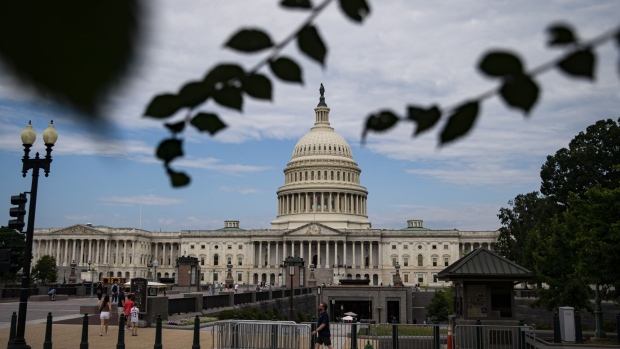Aug 1, 2023
US Credit Rating Downgraded From AAA by Fitch
, Bloomberg News

(Bloomberg) -- Fitch Ratings’ downgrade of US government debt sparked criticism from Washington and Wall Street even amid unease that swollen fiscal deficits risk eventual turbulence in markets, the economy and next year’s presidential election.
Fitch cut the US’s sovereign credit grade one level from AAA to AA+. The move comes just two months after it warned the rating was under threat as lawmakers flirted with default by battling over raising the nation’s debt limit.
The credit grader justified the shift by arguing the country’s finances will likely deteriorate over the next three years given tax cuts, new spending initiatives, economic shocks and repeated political gridlock.
Pushing back hours before her department is set to ramp up its borrowing to plug a ballooning budget deficit, Treasury Secretary Janet Yellen called the downgrade “arbitrary” and “outdated.” The economy has recently shown signs of resilience and the debt limit was ultimately lifted, she noted.
Mohamed El-Erian, the chief economic adviser at Allianz SE and a Bloomberg Opinion columnist, said he was “puzzled” by the announcement’s timing and predicted it wouldn’t carry much sway over investors.
The bond market shrugged off the downgrade. The yield on 10-year Treasuries was little changed in the London session, while the equivalent rate on German securities fell modestly. Risk-sensitive assets took a hit, with Europe’s Stoxx 600 Index tumbling the most in a month and US futures pointing to losses at the open.
Fitch’s action echoed one made in 2011 by S&P Global Ratings, which was never reversed. Although few investors see Treasuries shedding their status as the safest haven and most reliable source of collateral, the downgrade is still a spotlight on the worsening US fiscal outlook.
“While the US downgrade could prompt investors to glance at lofty public debt burdens, it is likely to be dismissed as a medium-term concern,” said Laura Cooper, senior investment strategist at BlackRock International. “Eventually those fiscal challenges will be in the purview of market participants and underpins our strategic view that investors will demand higher term premium from US Treasuries, keeping us underweight.”
The federal deficit hit $1.39 trillion for the first nine months of the current fiscal year, up some 170% from the same period the year before. The Treasury this week boosted its borrowing forecast for the current quarter to $1 trillion, well above the $733 billion it had predicted in May.
Such numbers helped lift the yield on 30-year US debt to the highest in almost nine months on Tuesday before Fitch spoke. The Treasury will reveal its quarterly financing plans on Wednesday at 8:30 a.m. in Washington.
Fitch’s downgrade sparked a fresh round of political bickering, which is likely to run through the November 2024 election. Democrats in Congress blamed Republicans for holding up the debt ceiling increase earlier this year, while the GOP pointed to President Joe Biden’s spending agenda, dubbed “Bidenomics.”
What Bloomberg Strategists Say...
“If you wanted to generate an outsized reaction to unexpected news, this is the month you would choose. Even the Treasury market suffers from liquidity issues.”
— Seb Boyd, MLIV strategist
Click here for the full report
Fitch had warned that it was weighing cutting the credit grade back in May, when Democrat and Republican lawmakers were at odds over raising the borrowing limit and the Treasury was only weeks away from running out of cash.
While that crisis was ultimately averted, Fitch nonetheless said that the repeated debt-limit clashes and eleventh-hour resolutions have eroded confidence in the country’s fiscal management.
It also highlighted the country’s rapidly mounting debt burden, which it forecasts to reach 118% of gross domestic product by 2025, more than two-and-a-half times higher than the AAA median of 39.3%.
The rating company projects the debt-to-GDP ratio to rise even further in the longer-term, increasing America’s vulnerability to future economic shocks, the report said.
Read the full statement from Treasury Secretary Janet Yellen here
When S&P downgraded the US more than a decade ago, the decision triggered a broad selloff in equities, but ironically boosted Treasuries as investors sought out havens.
“I suspect the market will be in two minds about it - at face value, it’s a black mark against the US’s reputation and standing, but equally, if it fuels market nervousness and a risk-off move, it could easily see safe haven buying of US Treasuries and the dollar,” said David Croy, strategist at Australia & New Zealand Banking Group in Wellington. “It’s finely balanced.”
The move by Fitch now gives the US two AA+ ratings. That could raise a problem for funds or index trackers with a AAA-only mandate, opening up the possibility of forced sales for compliance reasons.
Moody’s Investors Service still rates the US sovereign Aaa, its top grade.
--With assistance from Matthew Burgess, Erik Wasson and Andrew Dunn.
©2023 Bloomberg L.P.








